Design and Parametric Optimization Study of an Eccentric Parallelogram-Type Uprighting Device for Ratoon Rice Stubbles
Abstract
1. Introduction
2. Materials and Methods
2.1. Overall Structure and Working Principle
2.1.1. Characteristics of Stubble Plants
2.1.2. Overall Structure
2.1.3. Working Principle of the Uprighting Process
2.2. Design of Key Components of the Uprighting Device
2.2.1. Determination of Uprighting Teeth Spacing
2.2.2. Design of the Rotation Speed of the Uprighting Device
2.2.3. Determination of the Number of Uprighting Teeth Rows
2.3. Simulation Analysis
2.3.1. Establishment of Simulation Model
2.3.2. Simulation Analysis Metrics
2.3.3. Simulation Process and Analysis
2.4. Field Experiment
2.4.1. Test Prototype and Materials
2.4.2. Test Methods
3. Results
3.1. Field Test Result
3.2. Model Establishment and Analysis
3.3. Analysis of the Impact of Interactive Factors on the Stubble Straightening Rate
3.4. Analysis of the Influence Law of Interaction Factors on the Yield of Second-Season Rice in the Crushed Area
3.5. Verification of Experimental Results
4. Discussion
5. Conclusions
Author Contributions
Funding
Institutional Review Board Statement
Data Availability Statement
Acknowledgments
Conflicts of Interest
References
- Lin, W.; Chen, H.; Zhang, Z.; Xu, Q.; Tu, N.; Fang, C.; Ren, W. Research and prospect on physio-ecological properties of ratoon rice yield formation and its key cultivation technology. Chin. J. Eco-Agric. 2015, 23, 392–401. [Google Scholar]
- Peng, S.; Zheng, C.; Yu, X. Progress and challenges of rice ratooning technology in China. Crop Environ. 2023, 2, 5–11. [Google Scholar] [CrossRef]
- Huang, J.; Pan, Y.; Chen, H.; Zhang, Z.; Fang, C.; Shao, C.; Amjad, H.; Lin, W.; Lin, W. Physiochemical mechanisms involved in the improvement of grain-filling, rice quality me-diated by related enzyme activities in the ratoon cultivation system. Field Crops Res. 2020, 258, 107962. [Google Scholar] [CrossRef]
- Xu, Y.; Liang, L.; Wang, B.; Xiang, J.; Gao, M.; Fu, Z.; Long, P.; Luo, H.; Huang, C. Conversion from double-season rice to ratoon rice paddy fields reduces carbon footprint and enhances net ecosystem economic benefit. Sci. Total Environ. 2021, 813, 152550. [Google Scholar] [CrossRef]
- Tang, Q.Y.; Qing, X.G. Technological advancement and production development counter-measures of ratooning rice in Hunan Province. Hybrid Rice 2023, 38, 1–9. [Google Scholar]
- Fei, W.; Huang, J.; Shaobing, P. Research and development of mechanized rice ratooning technology in China. China Rice 2021, 27, 1–6. [Google Scholar]
- Wang, W.K.; Luo, C.M.; Zhang, G.Z.; Fu, J.W.; Dong, Z.; Ji, C.; Zhao, Z.Z. Design and experiment of automatic navigation system for rice harvester with dual-motor crawler chassis. J. Huazhong Agric. Univ. 2022, 41, 199–207. [Google Scholar]
- Zou, J.N.; Pang, Z.Q.; Zhou, L.I.; Guo, C.L.; Lin, H.M.; Zheng, L.I.; Chen, H.F.; Huang, J.W.; Ting, C.H.E.N.; Xu, H.L.; et al. Effects of Machine-cut Stubble Height on Morphological Development and Grain Yield of Subsequent Ratoon Rice Crop. Fujian J. Agric. Sci. 2016, 31, 791–796. [Google Scholar]
- Qian, T.; Mei, S.; Zhang, J.; Yu, J.; Zhai, Z.; Fang, X.; Chen, J.; Zhang, C.; Wei, T. Yield and yield components of ratoon rice with different stubble height and harvest methods. Hubei Agric. Sci. 2015, 54, 14–17. [Google Scholar]
- Xu, F.; Zhang, L.; Zhou, X.; Guo, X.; Zhu, Y.; Liu, M.; Jiang, P. The ratoon rice system with high yield and high efficiency in China: Progress, trend of theory and tech-nology. Field Crops Res. 2021, 272, 108282. [Google Scholar] [CrossRef]
- Yang, D.; Peng, S.; Zheng, C.; Xiong, Z.; Yang, G.; Deng, S.; Wang, F. Stubble height affects the grain yield of ratoon rice under rainfed conditions. Agric. Water Manag. 2022, 272, 107815. [Google Scholar] [CrossRef]
- Fu, J.; Ji, C.; Liu, H.; Wang, W.; Zhang, G.; Gao, Y.; Zhou, Y.; Abdeen, M.A. Research Progress and Prospect of Mechanized Harvesting Technology in the First Season of Ratoon Rice. Agriculture 2022, 12, 620. [Google Scholar] [CrossRef]
- Desheng, Y.; Jianliang, H.; Shaobing, P. Research Progresses of Mechanized Rice Ratooning Technology for Improving Grain Yield and Quality. China Rice 2023, 29, 1–8. [Google Scholar]
- Fu, J.; Zhang, G.; Xie, G.; Wang, Y.; Gao, Y.; Zhou, Y. Development of double-channel feeding harvester for ratoon rice. Trans. Chin. Soc. Agric. Eng. 2020, 36, 11–20. [Google Scholar]
- Liu, W.; Luo, X.; Zeng, S.; Zeng, L.; Wen, Z. The Design and Test of the Chassis of a Triangular Crawler-Type Ratooning Rice Harvester. Agriculture 2022, 12, 890. [Google Scholar] [CrossRef]
- Yang, Y.K.; Liu, J.; Huang, D.P.; Zeng, S.; Lai, Q.X. Design of full-feeding ratoon rice combine harvester. Hubei Agric. Sci. 2019, 58, 129. [Google Scholar]
- Mingsen, H. Research on Wide-Swath Layered Cutting and Adaptive Control Technology of Ratoon Rice. Ph.D. Thesis, Jiangsu University, Zhenjiang, China, 2022. [Google Scholar]
- Lu, K.; Zhang, G.; Peng, S.; Lei, Z.; Fu, J.; Zha, X.; Zhou, Y. Design and performance of tracked harvester for ratoon rice with double-headers and double threshing cylinders. J. Huazhong Agric. Univ. 2017, 36, 108–114. [Google Scholar]
- Li, H.L.; Liu, Z.P.; Liu, M.H.; Chen, X.F.; Yu, J.J.; Zhang, X.Y.; Peng, Y.F. Design and test of the righting device of crushed rice stubble after the mechanical harvesting of ratoon rice. J. Shenyang Agric. Univ. 2021, 52, 314–320. [Google Scholar]
- Zhang, X. Design and Experiment of Regenerative Rice Chain Row Claw Type Righting Device. Master’s Thesis, Jiangxi Agricultural University, Nanchang, China, 2019. [Google Scholar] [CrossRef]
- Chen, X.F.; Liang, X.H.; Liu, M.H.; Yu, J.J.; Li, H.L.; Liu, Z.P. Design and experiment of finger-chain grain lifter for ratoon rice stubble rolled by mechanical har-vesting. INMATEH-Agric. Eng. 2022, 66, 361–372. [Google Scholar] [CrossRef]
- Walunj, A.; Chen, Y.; Tian, Y.; Zeng, Z. Modeling Soil–Plant–Machine Dynamics Using Discrete Element Method: A Review. Agronomy 2023, 13, 1260. [Google Scholar] [CrossRef]
- Chen, G.; Wang, Q.; Li, H.; He, J.; Wang, X.; Zhang, X.; He, D. Experimental research on vertical straw cleaning and soil tillage device based on Soil-Straw composite model. Comput. Electron. Agric. 2024, 216, 108510. [Google Scholar] [CrossRef]
- Zhao, J.; Zhao, H.; Tang, H.; Wang, X.; Yu, Y. Bionic threshing component optimized based on MBD-DEM coupling simulation significantly improves corn kernel harvesting rate. Comput. Electron. Agric. 2023, 212, 108075. [Google Scholar] [CrossRef]
- Sun, K.; Yu, J.; Zhao, J.; Liang, L.; Wang, Y.; Yu, Y. A DEM-based general modeling method and experimental verification for wheat plants in the mature period. Comput. Electron. Agric. 2023, 214, 108283. [Google Scholar] [CrossRef]
- Shen, S.; He, Y.; Tang, Z.; Dai, Y.; Wang, Y.; Ma, J. Development of an Orchard Mowing and Sweeping Device Based on an ADAMS–EDEM Simulation. Agriculture 2023, 13, 2276. [Google Scholar] [CrossRef]
- Wang, J.; Xu, Y.; Wang, C.; Xiang, Y.; Tang, H. Design and simulation of a trenching device for rice straw burial and trenching based on MBD-DEM. Comput. Electron. Agric. 2023, 207, 107722. [Google Scholar] [CrossRef]
- Yi, Y. Research on the Expression Method of Rape Pod Shatter Resistance and Optimization Design of Rape Header’s Reel. Master’s Thesis, Jiangsu University, Zhenjiang, China, 2019. [Google Scholar]
- Yan, D.; Xu, T.; Yu, J.; Wang, Y.; Guan, W.; Tian, Y.; Zhang, N. Test and Simulation Analysis of the Working Process of Soybean Seeding Monomer. Agriculture 2022, 12, 1464. [Google Scholar] [CrossRef]
- Wang, Q.; Wang, Z.; Zhang, Z.; Zhang, K.; Yao, S.; Zhou, W.; Sun, X.; Wang, J. Design and Test of Bionic Elastic Row Cleaner with Improved Straw Cleaning Performance. Agriculture 2024, 14, 186. [Google Scholar] [CrossRef]
- Na, Y. Simulation Research on the Construction of Potato Ridge with Large Ridge and Double Rows Based on DEM-MBD Coupling Technology. Master’s Thesis, Lanzhou University of Technology, Lanzhou, China, 2018. [Google Scholar]
- Zeng, S.; Zeng, L.; Liu, W.J.; Wei, S.L.; Tu, Q.L.; Chen, H.B. Design and experiment of rigid-flexible coupling rod tooth threshing device of harvester for ratooning rice. J. South China Agric. Univ. 2022, 43, 61–69. [Google Scholar]
- Li, Y.; Su, Z.; Liang, Z.; Li, Y. Variable-diameter drum with concentric threshing gap and performance comparison experiment. Appl. Sci. 2020, 10, 5386. [Google Scholar] [CrossRef]
- Xu, L.; Li, Y.; Chai, X.; Wang, G.; Liang, Z.; Li, Y.; Li, B. Numerical simulation of gas–solid two-phase flow to predict the cleaning performance of rice combine harvesters. Biosyst. Eng. 2020, 190, 11–24. [Google Scholar] [CrossRef]


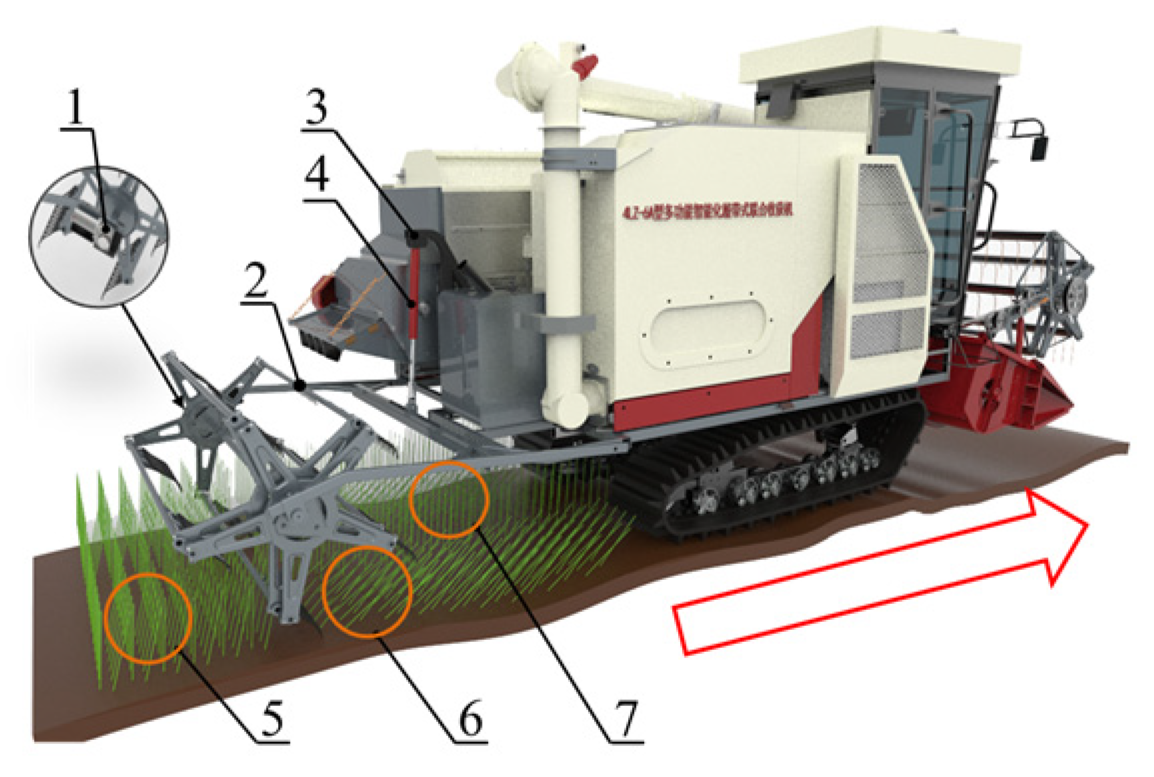
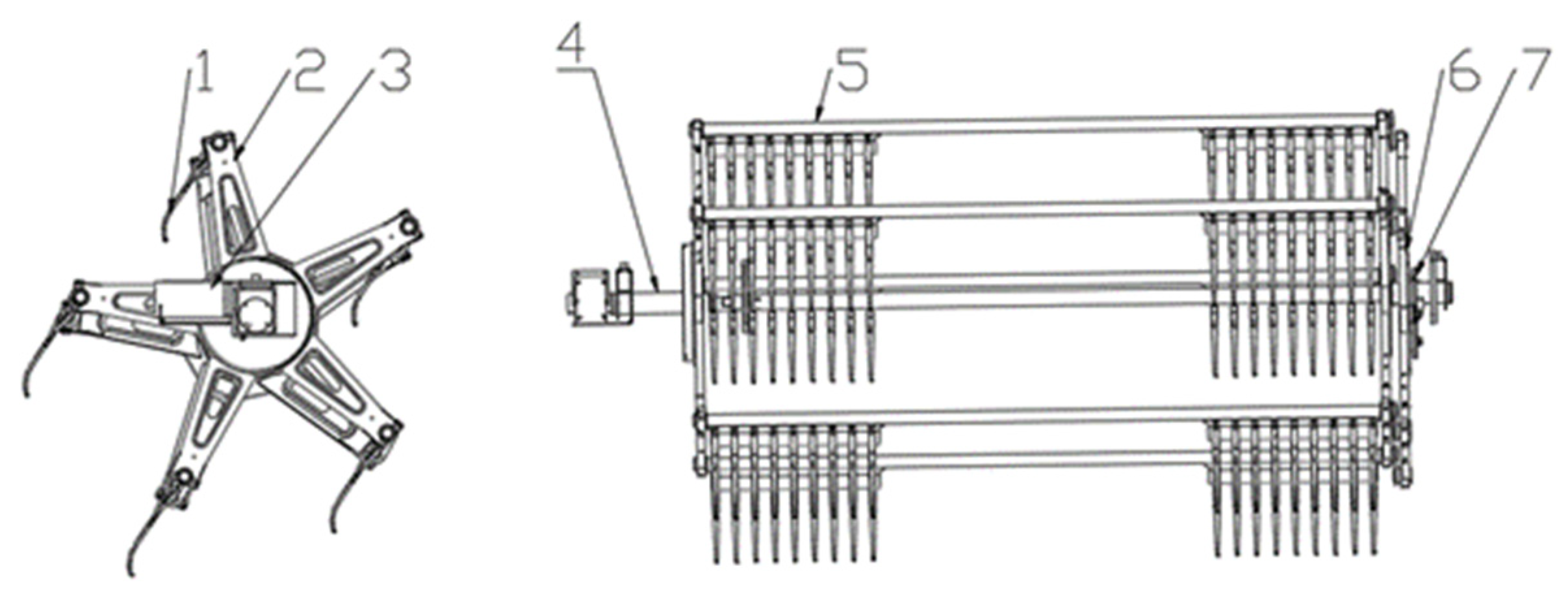
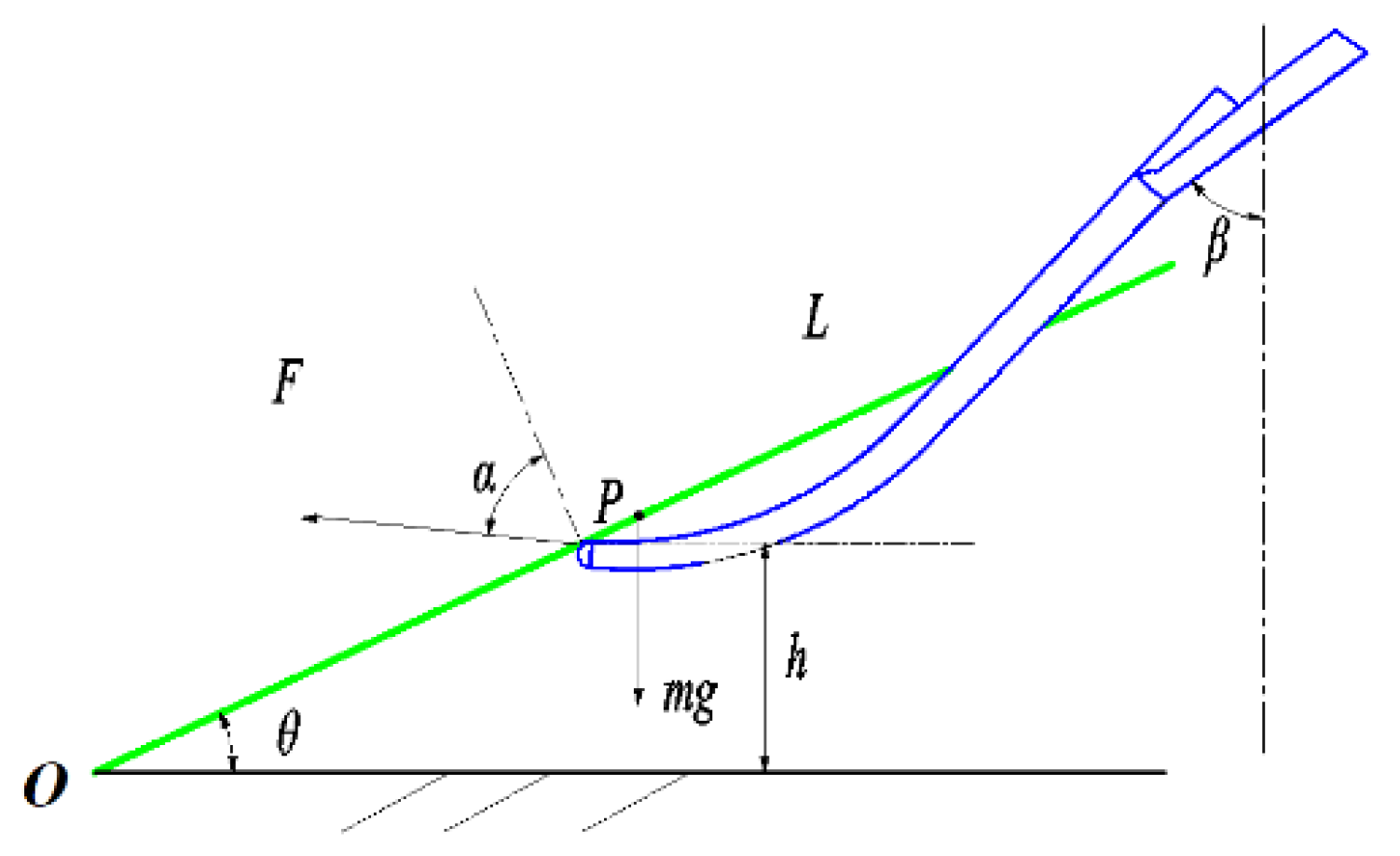


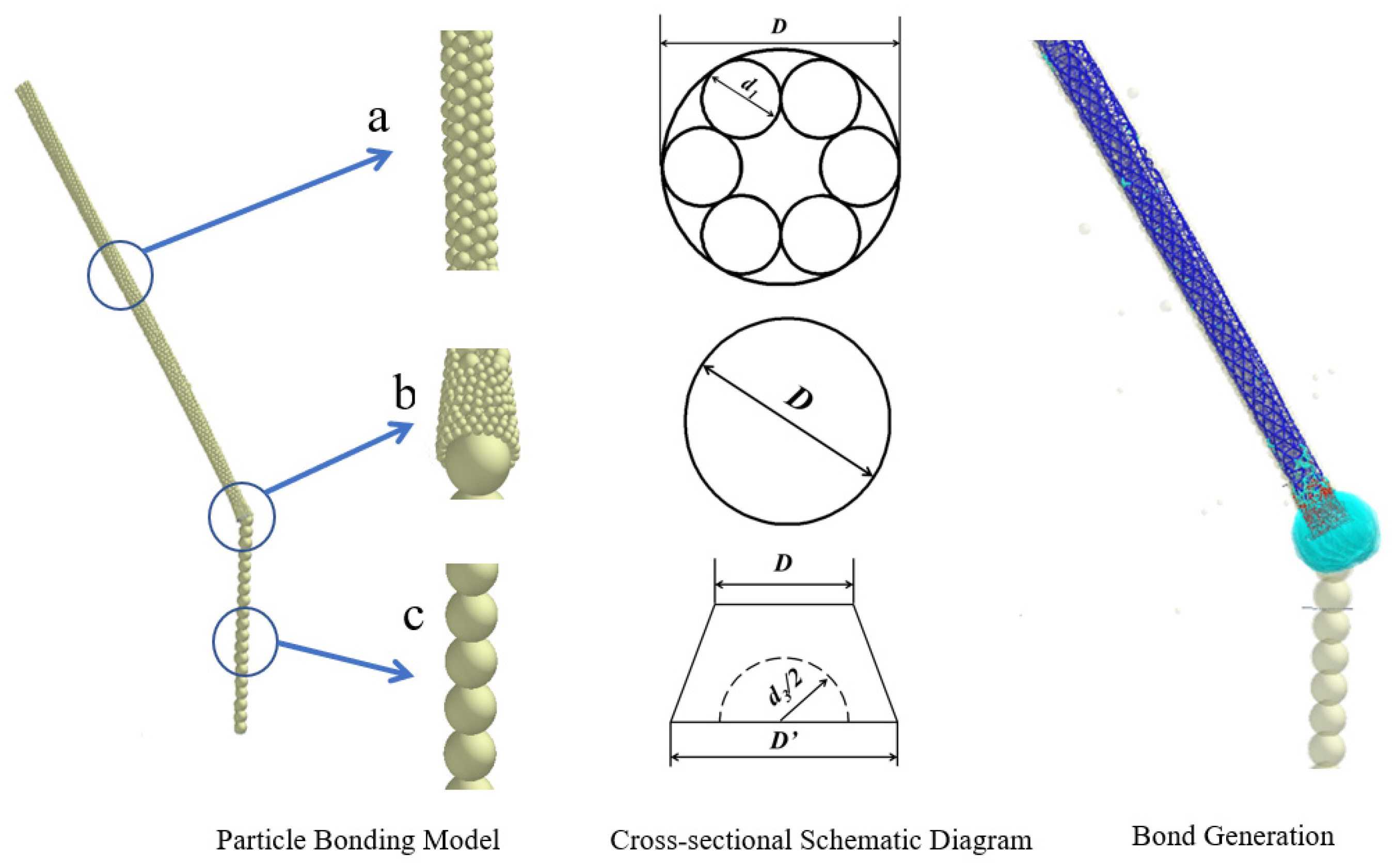


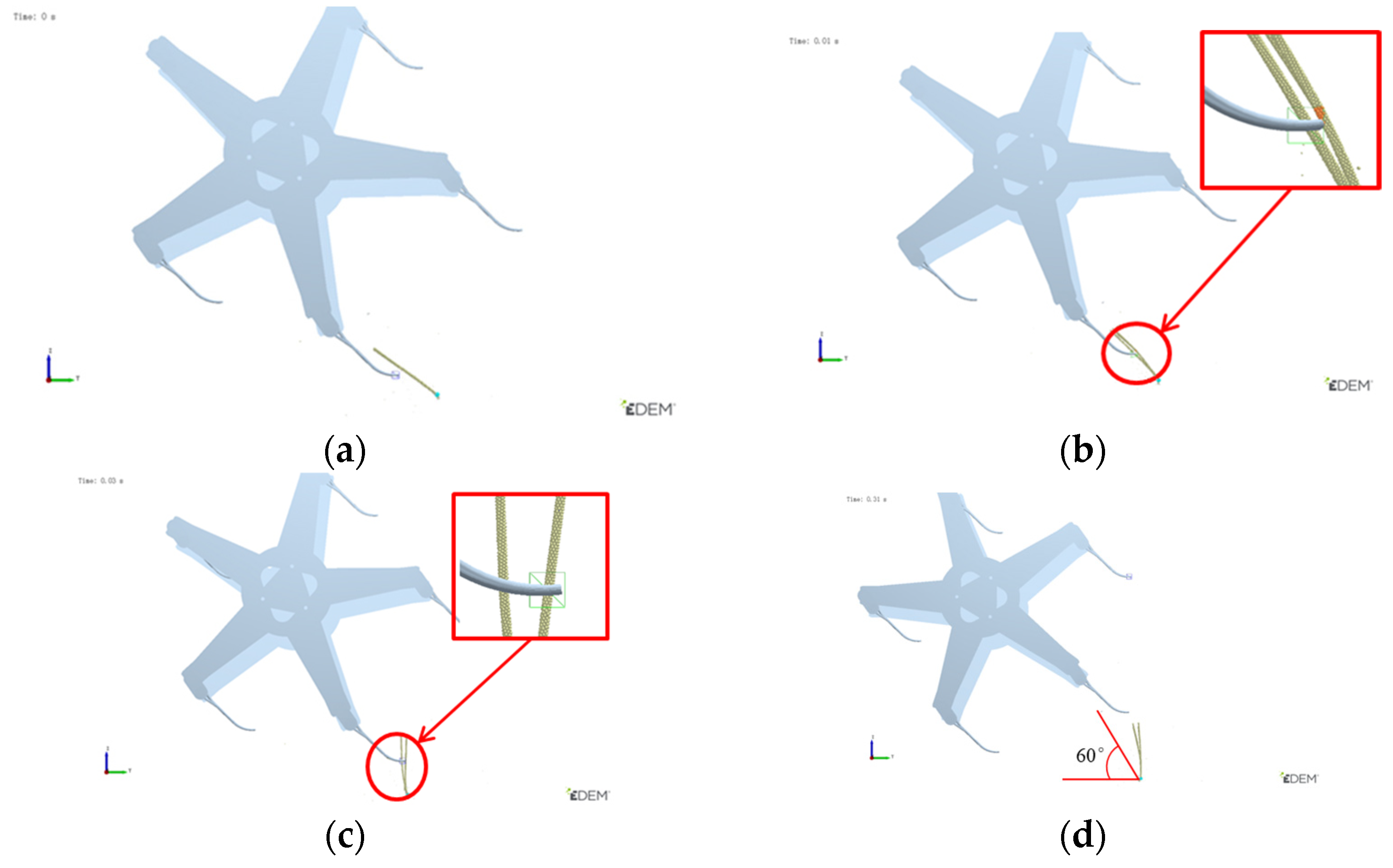

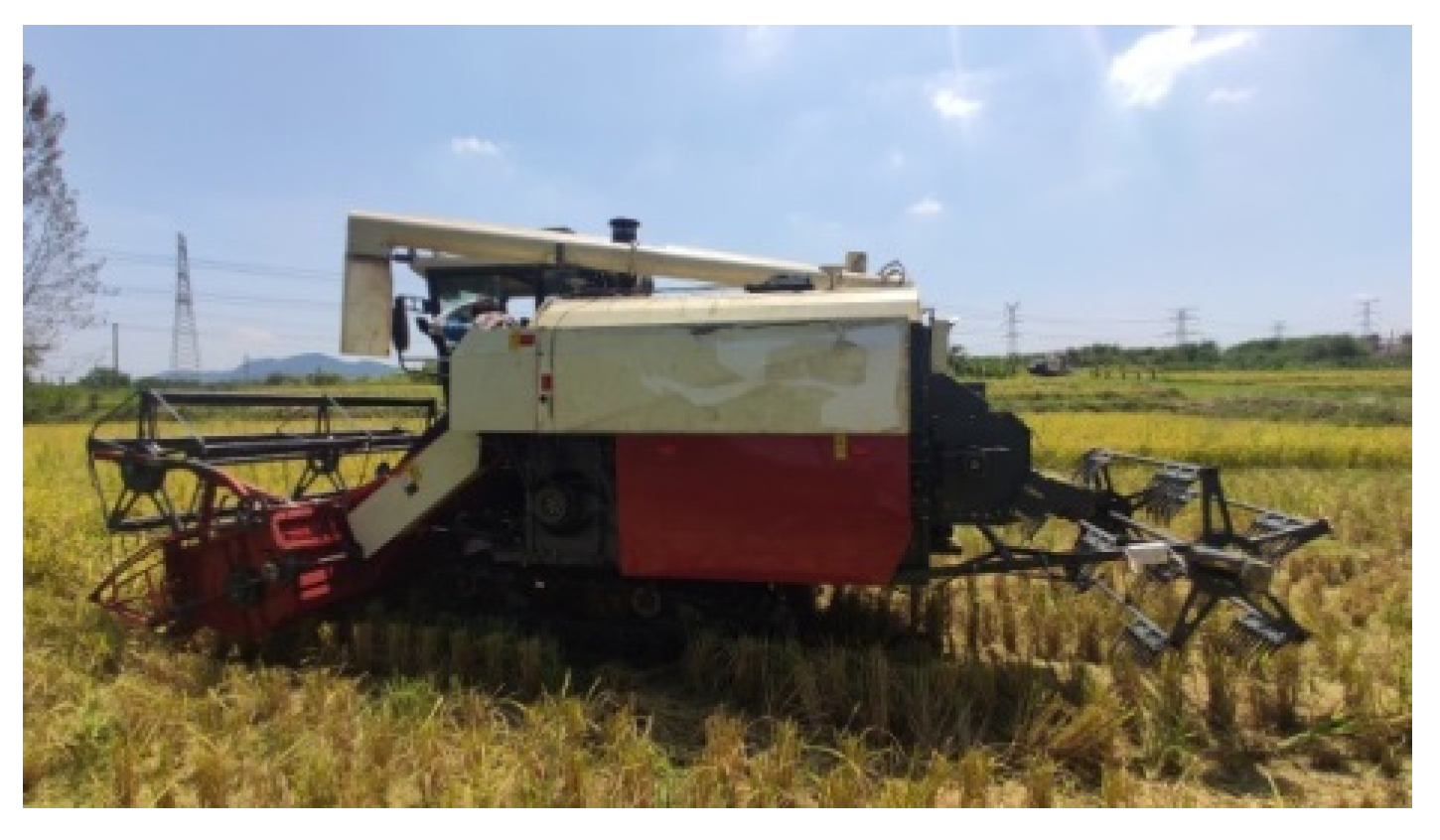



| Materials | Argument | Numerical Value |
|---|---|---|
| Surface Stubble/Stubble at Connection | Poisson’s ratio | 0.40 |
| density/(kg·m−3) | 180 | |
| Shear modulus/MPa | 9.0 | |
| Simplified Root | Poisson’s ratio | 0.40 |
| density/(kg·m−3) | 200 | |
| Shear modulus/MPa | 9.0 | |
| Nylon Prying Teeth | Poisson’s ratio | 0.34 |
| density/(kg·m−3) | 1140 | |
| Elastic Modulus/MPa | 130 | |
| Nylon Prying Teeth-Surface Stubble | Coefficient of Restitution | 0.40 |
| Static Friction Coefficient | 0.38 | |
| Rolling Friction Coefficient | 0.01 |
| Processing Method | Seed-Setting Rate (%) | Yield of Second-Season Rice in the Compacted Area (kg/hm2) |
|---|---|---|
| WY | 95.8 | 2771.5 |
| WF (0–30°) | 44.5 | 810 |
| RF (40–60°) | 85.6 | 1715 |
| RF 60–80° | 87.5 | 2155 |
| Experimental Projects | Rotational Speed (r/min) | Forward Speed (m/s) | Angle of Stubble Entry (°) |
|---|---|---|---|
| 1 | 15, 30, 60, 90, 120 | 1.25 | 45 |
| 2 | 60 | 1, 1.25, 1.5 | 45 |
| 3 | 60 | 1.25 | 15, 30, 45, 60, 75, 90 |
| Factor | Level | ||
|---|---|---|---|
| −1 | 0 | 1 | |
| A-Rotational Speed (r/min) | 45 | 60 | 75 |
| B-Forward Speed (m/s) | 1.00 | 1.25 | 1.50 |
| C-Angle of Stubble Entry (°) | 30 | 45 | 60 |
| Test Sequence | A (r/min) | B (m/s) | C (°) | Y1 (%) | Y2 (kg/hm2) |
|---|---|---|---|---|---|
| 1 | −1 | −1 | 0 | 85.79 | 1913 |
| 2 | 1 | −1 | 0 | 88.38 | 2145 |
| 3 | −1 | 1 | 0 | 85.88 | 2047 |
| 4 | 1 | 1 | 0 | 90.27 | 2142 |
| 5 | −1 | 0 | −1 | 86.63 | 1970 |
| 6 | 1 | 0 | −1 | 89.43 | 2202 |
| 7 | −1 | 0 | 1 | 85.25 | 1978 |
| 8 | 1 | 0 | 1 | 89.46 | 2113 |
| 9 | 0 | −1 | −1 | 88.03 | 2055 |
| 10 | 0 | 1 | −1 | 88.68 | 2146 |
| 11 | 0 | −1 | 1 | 86.35 | 1991 |
| 12 | 0 | 1 | 1 | 87.56 | 2045 |
| 13 | 0 | 0 | 0 | 88.22 | 2187 |
| 14 | 0 | 0 | 0 | 88.4 | 2147 |
| 15 | 0 | 0 | 0 | 87.94 | 2182 |
| 16 | 0 | 0 | 0 | 88.31 | 2176 |
| 17 | 0 | 0 | 0 | 88.5 | 2184 |
| Experimental Indicators | Source | Sum of Squares | DF | Mean Square | F-Value | p-Value | Significance |
|---|---|---|---|---|---|---|---|
| Y1 | Model | 31.28 | 9 | 3.48 | 54.37 | <0.0001 | ** |
| A | 24.47 | 1 | 24.47 | 382.74 | <0.0001 | ** | |
| B | 1.84 | 1 | 1.84 | 28.84 | 0.001 | ** | |
| C | 2.15 | 1 | 2.15 | 33.68 | 0.0007 | ** | |
| AB | 0.81 | 1 | 0.81 | 12.67 | 0.0092 | ** | |
| AC | 0.5 | 1 | 0.5 | 7.78 | 0.027 | * | |
| BC | 0.078 | 1 | 0.078 | 1.23 | 0.3047 | ||
| A2 | 0.45 | 1 | 0.45 | 7.1 | 0.0323 | * | |
| B2 | 0.56 | 1 | 0.56 | 8.81 | 0.0209 | * | |
| C2 | 0.27 | 1 | 0.27 | 4.22 | 0.0789 | ||
| Residual | 0.45 | 7 | 0.064 | ||||
| Lack of Fit | 0.26 | 3 | 0.088 | 1.93 | 0.2662 | ns | |
| Pure Error | 0.18 | 4 | 0.046 | ||||
| Sum | 31.73 | 16 | |||||
| R2 = 0.9859 Adj R2 = 0. 9678 Pre R2 = 0.8575 | |||||||
| Y2 | Model | 105 | 9 | 14,421.22 | 46.62 | <0.0001 | ** |
| A | 104 | 1 | 60,204.50 | 194.63 | <0.0001 | ** | |
| B | 103 | 1 | 9522.00 | 30.78 | 0.0009 | ** | |
| C | 103 | 1 | 7564.50 | 24.45 | 0.0017 | ** | |
| AB | 103 | 1 | 4692.25 | 15.17 | 0.0059 | ** | |
| AC | 103 | 1 | 2352.25 | 7.60 | 0.0282 | * | |
| BC | 102 | 1 | 342.25 | 1.11 | 0.3278 | ||
| A2 | 104 | 1 | 12,040.32 | 38.92 | 0.0004 | ** | |
| B2 | 104 | 1 | 15,145.27 | 48.96 | 0.0002 | ** | |
| C2 | 104 | 1 | 13,192.42 | 42.65 | 0.0003 | ** | |
| Residual | 103 | 7 | 309.33 | ||||
| Lack of Fit | 103 | 3 | 368.83 | 1.39 | 0.3668 | ns | |
| Pure Error | 103 | 4 | 264.70 | ||||
| Sum | 105 | 16 | |||||
| R2 = 0.9836 Adj R2 = 0.9625 Pre R2 = 0.8535 | |||||||
| Norm | Stubble Straightening Rate (%) | Error (%) | Yield of Second-Season Rice in the Compacted Area (kg/hm2) | Error (kg/hm2) |
|---|---|---|---|---|
| Theoretical value | 90.10 | 2202.64 | ||
| Verification result | 87.00 | −3.10 | 2190.00 | −12.64 |
| 91.00 | 0.90 | 2235.00 | 32.36 | |
| 88.00 | −2.10 | 2195.00 | −7.64 | |
| 88.67 | −1.43 | 2206.67 | 4.03 |
Disclaimer/Publisher’s Note: The statements, opinions and data contained in all publications are solely those of the individual author(s) and contributor(s) and not of MDPI and/or the editor(s). MDPI and/or the editor(s) disclaim responsibility for any injury to people or property resulting from any ideas, methods, instructions or products referred to in the content. |
© 2024 by the authors. Licensee MDPI, Basel, Switzerland. This article is an open access article distributed under the terms and conditions of the Creative Commons Attribution (CC BY) license (https://creativecommons.org/licenses/by/4.0/).
Share and Cite
Xing, S.; Yu, Y.; Cao, G.; Hu, J.; Zhu, L.; Liu, J.; Wu, Q.; Li, Q.; Xu, L. Design and Parametric Optimization Study of an Eccentric Parallelogram-Type Uprighting Device for Ratoon Rice Stubbles. Agriculture 2024, 14, 534. https://doi.org/10.3390/agriculture14040534
Xing S, Yu Y, Cao G, Hu J, Zhu L, Liu J, Wu Q, Li Q, Xu L. Design and Parametric Optimization Study of an Eccentric Parallelogram-Type Uprighting Device for Ratoon Rice Stubbles. Agriculture. 2024; 14(4):534. https://doi.org/10.3390/agriculture14040534
Chicago/Turabian StyleXing, Shuaifeng, Yang Yu, Guangqiao Cao, Jinpeng Hu, Linjun Zhu, Junyu Liu, Qinhao Wu, Qibin Li, and Lizhang Xu. 2024. "Design and Parametric Optimization Study of an Eccentric Parallelogram-Type Uprighting Device for Ratoon Rice Stubbles" Agriculture 14, no. 4: 534. https://doi.org/10.3390/agriculture14040534
APA StyleXing, S., Yu, Y., Cao, G., Hu, J., Zhu, L., Liu, J., Wu, Q., Li, Q., & Xu, L. (2024). Design and Parametric Optimization Study of an Eccentric Parallelogram-Type Uprighting Device for Ratoon Rice Stubbles. Agriculture, 14(4), 534. https://doi.org/10.3390/agriculture14040534







